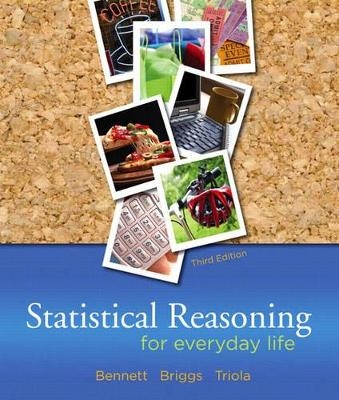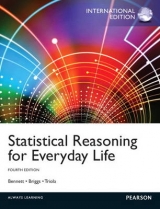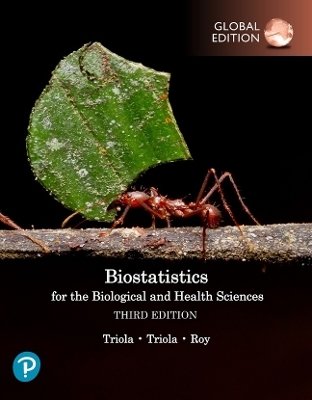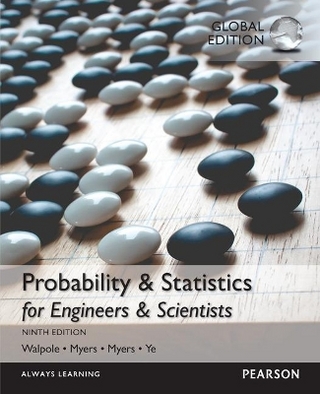
Statistical Reasoning for Everyday Life
Pearson
978-0-321-28672-7 (ISBN)
- Titel erscheint in neuer Auflage
- Artikel merken
Jeffrey Bennett specializes in mathematics and science education. In addition to his work in mathematics, Dr. Bennett (whose PhD is in astrophysics) has written leading college-level textbooks in mathematics, astronomy, statistics, and the new science of astrobiology, as well as books for the general public. He also proposed and developed both the Colorado Scale Model Solar System on the University of Colorado at Boulder campus and the Voyage Scale Model Solar System, a permanent, outdoor exhibit on the National Mall in Washington, DC. He has recently begun writing science books for children, including the award-winning Max Goes to the Moon and Max Goes to Mars. William L. Briggs has been on the mathematics faculty at the University of Colorado at Denver for 22 years. He developed the quantitative reasoning course for liberal arts students at the University of Colorado at Denver, supported by his textbook Using and Understanding Mathematics. He is a University of Colorado President's Teaching Scholar, an Outstanding Teacher awardee of the Rocky Mountain Section of the MAA, and the recipient of a Fulbright Fellowship to Ireland. Mario F. Triola is a Professor Emeritus of Mathematics at Dutchess Community College, where he taught statistics for more than 30 years. Marty [change to Dr. Triola to match Dr. Bennett above?] is the author of Elementary Statistics, Elementary Statistics Using Excel, Elementary Statistics Using the TI-83/84 Plus Calculator, Essentials of Statistics, and a co-author of Biostatistics for the Biological and Health Sciences, Statistical Reasoning for Everyday Life, and Business Statistics. He has written several manuals and workbooks for technology supporting statistics education. The Text and Academic Authors Association has awarded Mario F. Triola a “Texty” for Excellence, for his work on Elementary Statistics.
Preface
Supplements
To the Student: How to Succeed in Your Statistics Course
Applications Index
1. Speaking of Statistics
1.1 What Is/Are Statistics?
1.2 Sampling
1.3 Types of Statistical Studies
1.4 Should You Believe a Statistical Study?
Focus on Sociology: Does Daycare Breed Bullies?
Focus on Public Health: Is Your Lifestyle Healthy?
2. Measurement in Statistics
2.1 Data Types and Levels of Measurement
2.2 Dealing with Errors
2.3 Uses of Percentages in Statistics
2.4 Index Numbers
Focus on Politics: Who Benefits from a Tax Cut?
Focus on Economics: Is our Standard of Living Improving?
3. Visual Displays of Data
3.1 Frequency Tables
3.2 Picturing Distributions of Data
3.3 Graphics in the Media
3.4 A Few Cautions About Graphics
Using Technology
Focus on History: Can War Be Described with a Graph?
Focus on Environment: How Can We Visualize Global Warming?
4. Describing Data
4.1 What Is Average?
4.2 Shapes of Distributions
4.3 Measures of Variation
4.4 Statistical Paradoxes
Using Technology
Focus on The Stock Market: What’s Average About the Dow?
Focus on Economics: Are the Rich Getting Richer?
5. A Normal World
5.1 What Is Normal?
5.2 Properties of the Normal Distribution
5.3 The Central Limit Theorem
Using Technology
Focus on Education: What Can We Learn from SAT Trends?
Focus on Psychology: Are We Smarter than Our Parents?
6. Probability in Statistics
6.1 The Role of Probability in Statistics: Statistical Significance 226
6.2 Basics of Probability
6.3 Probabilities with Large Numbers
6.4 Ideas of Risk and Life Expectancy
6.5 Combining Probabilities (Supplementary Section)
Focus on Social Science: Are Lotteries Fair?
Focus on Law: Is DNA Fingerprinting Reliable?
7. Correlation and Causality
7.1 Seeking Correlation
7.2 Interpreting Correlations
7.3 Best-Fit Lines and Prediction
7.4 The Search for Causality
Using Technology
Focus on Education: What Helps Children Learn to Read?
Focus on Environment: What Causes Global Warming?
8. From Samples to Populations
8.1 Sampling Distributions
8.2 Estimating Population Means
8.3 Estimating Population Proportions
Using Technology
Focus on History: Where Did Statistics Begin?
Focus on Literature: How Many Words Did Shakespeare Know?
9. Hypothesis Testing
9.1 Fundamentals of Hypothesis Testing
9.2 Hypothesis Tests for Population Means
9.3 Hypothesis Testing: Population Proportions
Using Technology
Focus on Health & Education: Will Your Education Help You Live Longer?
Focus on Agriculture: Are Genetically Modified Foods Safe?
10. t Tests, Two-Way Tables, and ANOVA
10.1 Distribution for Inferences about a Mean
10.2 t Hypothesis Testing with Two-Way Tables
10.3 Analysis of Variance (One-Way ANOVA)
Using Technology
Focus on Criminology: Can You Tell a Fraud When You See One?
Focus on Education: What Can a Fourth-Grader Do with Statistics?
Epilogue: A Perspective on Statistics
Appendix A: z-Score Tables
Appendix B: Table of Random Numbers
Suggested Readings
Credits
Glossary
Answers
Index
| Erscheint lt. Verlag | 13.3.2008 |
|---|---|
| Sprache | englisch |
| Maße | 254 x 213 mm |
| Gewicht | 962 g |
| Themenwelt | Mathematik / Informatik ► Mathematik ► Statistik |
| ISBN-10 | 0-321-28672-3 / 0321286723 |
| ISBN-13 | 978-0-321-28672-7 / 9780321286727 |
| Zustand | Neuware |
| Haben Sie eine Frage zum Produkt? |
aus dem Bereich


